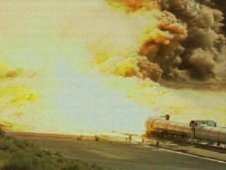Second Attempt At Test Firing Goes Smoothly
 NASA and industry engineers
conducted the initial full-scale, full-duration test firing of the
first stage motor for the Ares I rocket Thursday at a test facility
in Utah. The Ares I is a crew launch vehicle in development for
NASA's Constellation Program.
NASA and industry engineers
conducted the initial full-scale, full-duration test firing of the
first stage motor for the Ares I rocket Thursday at a test facility
in Utah. The Ares I is a crew launch vehicle in development for
NASA's Constellation Program.
ATK Space Systems conducted the successful stationary firing of
the five-segment solid development motor 1, or DM-1. ATK Space
Systems, a division of Alliant Techsystems of Brigham City, Utah,
is the prime contractor for the Ares I first stage. Engineers will
use the measurements gathered from the test to evaluate thrust,
roll control, acoustics and motor vibrations. This data will
provide valuable information as NASA develops the Ares I and Ares V
vehicles. Another ground test is planned for summer 2010.
"With this test, we have taken lessons learned from many years
of experience in solid rocket motor development and have built on
that foundation," said Alex Priskos, first stage manager for Ares
Projects at NASA's Marshall Space Flight Center in Huntsville, Ala.
"Our team collected data from 650 sensors today to evaluate the
motor's performance. This test and those that follow are essential
to understanding as many aspects of our motor as possible,
including strengths and weaknesses, and ultimately delivering the
safest and most reliable motor possible."

Ares Test Photo Courtesy
NASA
This was the second attempt to conduct the two-minute rocket
test at ATK's test stand in Promontory, Utah. The first test on
Aug. 27 was canceled with 20 seconds left in the countdown because
of a problem with a component of the ground controller unit, which
sends power to the system that moves the nozzle during the test.
Through a detailed investigation, the engineering team pinpointed
the problem and replaced the faulty part.
The first stage motor will generate up to 3.6 million pounds of
thrust, or lifting power, at launch. Although similar to the solid
rocket boosters that help power the space shuttle to orbit, the
Ares development motor includes several upgrades and technology
improvements implemented by NASA and ATK engineers.
Motor upgrades from a shuttle booster include the addition of a
fifth segment, a larger nozzle throat, and upgraded insulation and
liner. The forward motor segment also has been improved for
performance by adding another fin, or slot in the propellant. This
change in the geometry of the propellant provides additional
surface area for burning the solid fuel, which results in greater
thrust.

Ares X1 Assembled
The DM-1 nozzle throat is three inches wider in diameter than
the nozzle used for the shuttle. The bigger nozzle throat allows
the motor to handle the additional thrust from the five-segment
booster. It also meets NASA's structural requirements to stay
within the pressure capacity of the existing steel cases -- the
large, barrel-shaped cylinders that house the fuel -- ensuring
safety and reliability. Upgrades also were made to the insulation
and liner that protect the first stage's steel cases.
The motor cases are flight proven hardware used on shuttle
launches for more than three decades. The cases used in this ground
test have collectively flown on 48 previous missions, including
STS-1, the first shuttle flight.
Marshall manages the Ares Projects and is responsible for design
and development of the Ares I rocket and Ares V heavy cargo launch
vehicle. NASA's Johnson Space Center in Houston manages the
Constellation Program, which includes the Ares I, Ares V, Orion
crew module and Altair lunar lander. The program also includes
multiple project teams at NASA centers and contract organizations
around the United States.
 ANN's Daily Aero-Term (05.05.24): Omnidirectional Approach Lighting System
ANN's Daily Aero-Term (05.05.24): Omnidirectional Approach Lighting System Aero-News: Quote of the Day (05.05.24)
Aero-News: Quote of the Day (05.05.24) Airborne 05.06.24: Gone West-Dick Rutan, ICON BK Update, SpaceX EVA Suit
Airborne 05.06.24: Gone West-Dick Rutan, ICON BK Update, SpaceX EVA Suit Airborne 05.03.24: Advanced Powerplant Solutions, PRA Runway Woes, Drone Racing
Airborne 05.03.24: Advanced Powerplant Solutions, PRA Runway Woes, Drone Racing Aero-News: Quote of the Day (05.06xx.24)
Aero-News: Quote of the Day (05.06xx.24)





